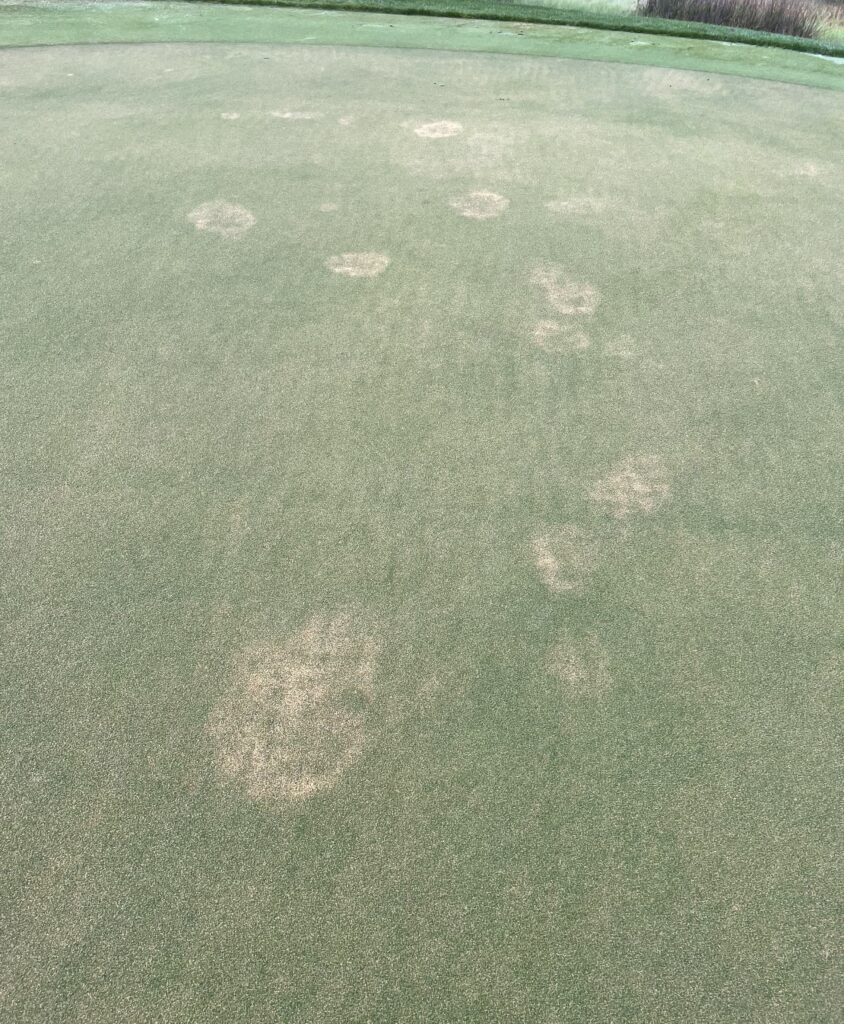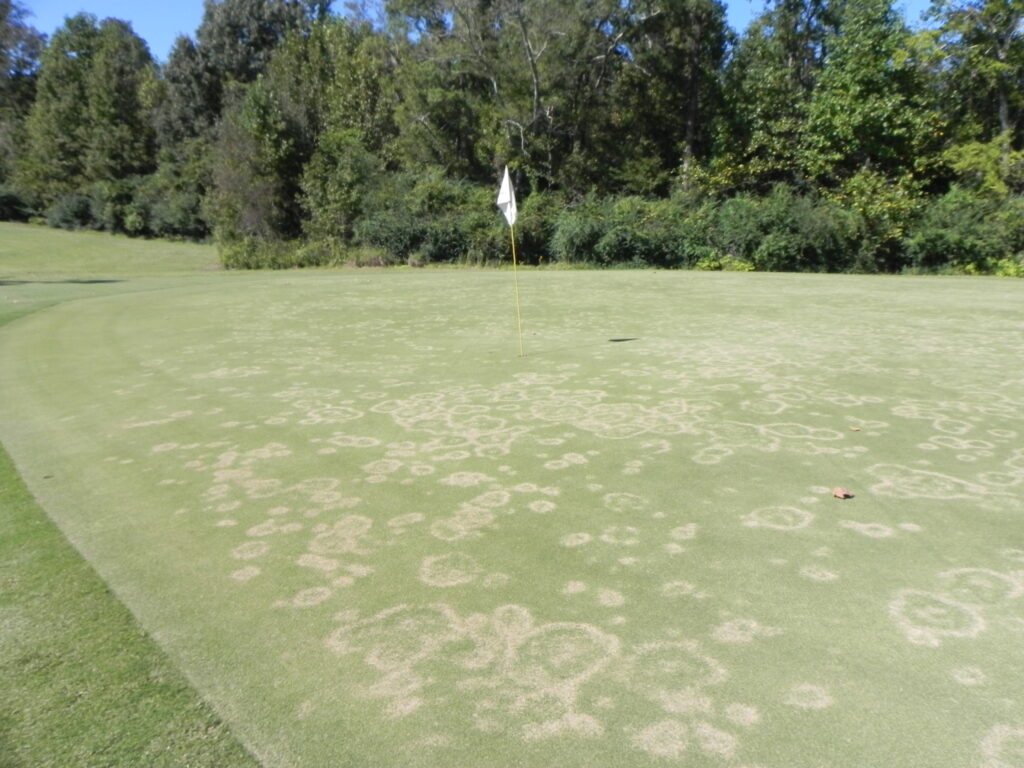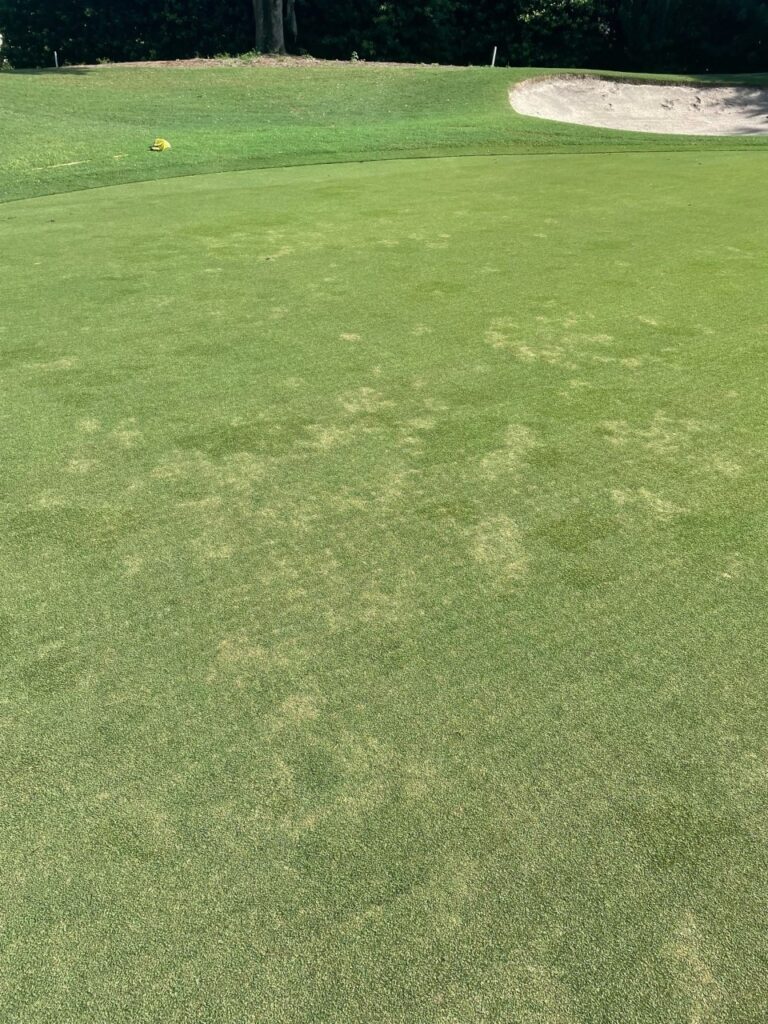Why Should You Love Soil Temperatures When Managing Bermudagrass Diseases?
go.ncsu.edu/readext?957153
en Español / em Português
El inglés es el idioma de control de esta página. En la medida en que haya algún conflicto entre la traducción al inglés y la traducción, el inglés prevalece.
Al hacer clic en el enlace de traducción se activa un servicio de traducción gratuito para convertir la página al español. Al igual que con cualquier traducción por Internet, la conversión no es sensible al contexto y puede que no traduzca el texto en su significado original. NC State Extension no garantiza la exactitud del texto traducido. Por favor, tenga en cuenta que algunas aplicaciones y/o servicios pueden no funcionar como se espera cuando se traducen.
Português
Inglês é o idioma de controle desta página. Na medida que haja algum conflito entre o texto original em Inglês e a tradução, o Inglês prevalece.
Ao clicar no link de tradução, um serviço gratuito de tradução será ativado para converter a página para o Português. Como em qualquer tradução pela internet, a conversão não é sensivel ao contexto e pode não ocorrer a tradução para o significado orginal. O serviço de Extensão da Carolina do Norte (NC State Extension) não garante a exatidão do texto traduzido. Por favor, observe que algumas funções ou serviços podem não funcionar como esperado após a tradução.
English
English is the controlling language of this page. To the extent there is any conflict between the English text and the translation, English controls.
Clicking on the translation link activates a free translation service to convert the page to Spanish. As with any Internet translation, the conversion is not context-sensitive and may not translate the text to its original meaning. NC State Extension does not guarantee the accuracy of the translated text. Please note that some applications and/or services may not function as expected when translated.
Collapse ▲As the summer is coming to a close, except for 100oF temperatures in September, we are in the window to manage those important diseases of ultradwarf bermudagrass putting greens. Spring dead spot applications are also knocking on the door and the key to all of these is watching soil temperatures! There are three things that govern disease severity: the pathogen, the host, and the environment with, in our opinion, the environment as the most important factor. Regardless of temperatures, bermudagrass growth is going to slow down, and given that turfgrass pathogens are ubiquitous (everywhere), diseases are likely going to develop. The diseases that are of utmost concern are take-all root rot (TARR), mini-ring, Pythium root rot, spring dead spot, leaf spot, cream leaf blight, and Pythium blight. This post will address all of these diseases.
Take-all Root Rot:
The pathogens that cause TARR are actively growing when soil temperatures are between 86 and 68oF, yet grow best when temperatures are between 86 and 75oF. That window is now and this year is a little later than previous years because we were pretty hot through August. In our experience, fungicides targeting TARR should be applied every 14 to 21 during this timeframe to ensure adequate suppression. Unfortunately, 28-day re-application intervals have not worked in our trials. Based on recent research from our lab, fertilizing with ammonium sulfate or potassium nitrate reduced TARR severity and applications of manganese also help to reduce the disease severity. These pathogens affect the nodes on the stolons and rhizomes so fungicide applications should be irrigated in immediately after the application with 1/8 inch of water. We have NO EARTHLY idea how many minutes that is at your course! The research clearly shows that you cannot apply too much water for soilborne pathogens. If you can time these applications around a solid tine aerification or vertical mowing that could help the fungicide penetrate into the area where the pathogens are. Staying on a wetting agent program will also help fungicide movement into the root zone.
To learn more about take-all root rot, please visit the link below:
Take-all Root Rot
Leaf and Sheath Spot (a.k.a. Mini-ring):
The pathogen that causes mini-ring or leaf and sheath spot on bermudagrass is most active when temperatures are warm, or at least we are able to isolate the pathogen readily in August. It is relatively rare to see mini-ring and TARR together on the same course, so managing these two can be separate. Mini-ring is best managed by using urea as the nitrogen source and targeting preventative fungicides in mid to late June to mid-July. Products such as Densicor, Ascernity, and Briskway should be the staples for managing this disease. Given that the timing is somewhat similar to TARR and these fungicides also have good to excellent TARR activity could be another reason why these two are not typically observed together. The problem with mini-ring is its unpredictability as in some years we see excellent control with 21 or 28-day re-application intervals, but in others, only 14-day applications work. One of our main observations with this disease is that it is most severe when the plant is highly regulated or lacks fertility. This pathogen also affects the nodes on the stolons and rhizomes, so fungicides should be watered in immediately after they are applied.
To learn more about leaf and sheath spot, please visit the link below:
Leaf and Sheath Spot (a.k.a mini-ring)
Pythium Root Rot:
Pythium root rot is a problem on ultradwarf bermudagrasses. We normally see samples in the Turfgrass Diagnostic Lab from late July through the fall. The symptoms of Pythium root rot look very similar to those of TARR, so do not assume the white patches are solely TARR. We have commonly seen Pythium root rot and TARR on the same golf course, thus when spraying for TARR it is beneficial to spray for Pythium root rot too. There are some options to consider as tank-mix partners when spraying for Pythium root rot, Serata, and Segway. The low rates of both of these materials work great! A new product called Resilia might be a good fit this time of year as well because the three active ingredients provide a good start in protecting roots for the stressful fall, winter, and spring months. Once again, these materials should be watered in with at least 1/8 inch of irrigation immediately after the application.
To learn more about Pythium root rot, please visit the link below:
Pythium Root Rot
Foliar Diseases: (Cream Leaf Blight, Leaf Spot, Pythium Blight)

Symptoms of three common foliar diseases on ultradwarf bermudagrass putting greens; cream leaf blight, leaf spot, and Pythium blight.
These diseases can occur almost at any time of year. However, based on the data from the Turfgrass Diagnostic Lab we typically see cream leaf blight over the winter months, leaf spot in the spring and summer, and Pythium blight in the fall. Again, this is what we typically see and that can change if the conditions are right. When these diseases occur outside of those typical windows it is usually due to extended periods of cloud cover that dramatically slow the growth of bermudagrasses. The beauty of these diseases is they are easily controlled with contact fungicides such as Secure, Mancozeb, and Daconil for leaf spots, almost any Pythium product for Pythium blight, and almost any systemic material for cream leaf blight. For some reason, we do not see good suppression of cream leaf blight with contact fungicides. Another important point with foliar diseases is to remain on a consistent phosphonate or phosphite program. Phosphites provide excellent suppression of foliar diseases and also help with other diseases such as Pythium root rot.
To learn more about these foliar diseases, please visit the links below:
Cream Leaf Blight
Leaf Spot
Pythium Blight
Nematodes, Spring Dead Spot, and Fairy Ring:
Nematode feeding, especially from sting nematodes, can start during the fall and winter months depending on where you are. We commonly see an association between nematode feeding and soilborne diseases, therefore if you struggle with any of the root diseases listed above you probably want to consider a nematicide program as well. The key with nematodes is to understand what species are present before designing your program to manage them. There are some excellent labs that can assist with nematode diagnostics such as the University of Florida, Clemson, and the North Carolina Department of Ag Nematode Lab. It is strongly suggested that you look at their website prior to submitting a sample to understand how they want the samples collected prior to sending.
Spring dead spot applications should occur when soil temperatures drop to 75oF in the fall. Given that TARR is likely still active it is important to pick materials that cover both diseases. We have rarely seen issues on putting greens recently, likely due to many treating preventatively for TARR or mini-ring. For fairway applications products such as Kabuto, Maxtima and Posterity are excellent choices. Fairy ring can grow in the fall as well, so pick TARR and spring dead spot materials that provide suppression of those fungi if possible.
To learn more about these soil-borne diseases, please visit the links below:
Nematodes
Spring Dead Spot
Fairy Ring
Hope this is helpful for everyone and we wish everyone a successful fall managing these challenging diseases! As always, please don’t hesitate to reach out via email or phone if you have any questions.






